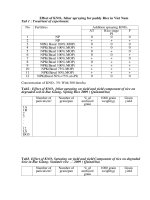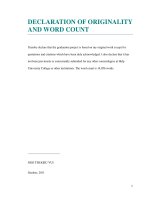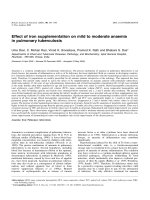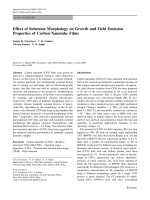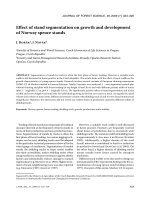Effect of nanozinc supplementation on haematological and blood biochemical profiles in goats
Bạn đang xem bản rút gọn của tài liệu. Xem và tải ngay bản đầy đủ của tài liệu tại đây (208.88 KB, 9 trang )
Int.J.Curr.Microbiol.App.Sci (2019) 8(9): 2688-2696
International Journal of Current Microbiology and Applied Sciences
ISSN: 2319-7706 Volume 8 Number 09 (2019)
Journal homepage:
Original Research Article
/>
Effect of Nanozinc Supplementation on Haematological and Blood
Biochemical Profiles in Goats
P. S. Swain1,2*, S. B. N. Rao1, D. Rajendran1, K. T. Poornachandra2,
E. Lokesha2 and R. Dhinesh Kumar2
1
ICAR-National Institute of Animal Nutrition and Physiology, Bangalore, 560030, India
2
Dairy Cattle Nutrition Division, ICAR- National Dairy Research Institute, Karnal,
Haryana, 132001, India
*Corresponding author
ABSTRACT
Keywords
Blood biochemistry;
Goats;
Haematology; Nano
zinc; Zinc Oxide.
Article Info
Accepted:
24 August 2019
Available Online:
10 September 2019
A study was conducted to evaluate the efficiency of nano zinc (NZn) as feed
supplementation on haematological and blood biochemical profiles in goats (Capra
hircus). NZn was synthesized by from 0.45 M aqueous solution of zinc nitrate
[Zn(NO3)2.6H2O] and 0.9 M aqueous solution of sodium hydroxide (NaOH). The particle
size thus obtained was 74 nm and later it was confirmed to be zinc by using TEM-EDAX.
Twenty four male goats were divided into 4 groups on the basis of body weight and were
supplemented with either basal diet i.e. Concentrate mixture and finger millet (Eleusine
corocana) straw @ 50: 50 ratio (BD) which was considered as Negative control (NC), BD
with 50 mg/kg zinc from inorganic ZnO (IZn-50), BD with 50 mg/kg zinc from NZnO
(NZn-50) or BD with 25 mg/kg zinc from NZnO (NZn-25) for about 4 months.
Supplementation of zinc from either inorganic or nano Zn had no effect (P>0.05) on RBC
(106/ µl), WBC(103/ µl), PCV (%), neutrophil (%), lymphocytes (%), eisonophil (%),
monocyte (%), haemoglobin (g/dL), ALT (IU/L), AST (IU/L), ALP (IU/L) and creatinine
(mg/DL) levels of goat blood. However, globulin (g/dL) and total protein (g/dL) varied
significantly among the treatment groups (P<0.01) without affecting blood albumin (g/dL)
and A/G ratio levels (P>0.05). The globulin level was more (P<0.01) in NZn-50 compared
to both NC and IZn-50. Total protein (g/dL) was more (P<0.001) in NZn-50 which varied
significantly with NZn-25 and NC, but non-significantly with IZn-50 (6.87±0.01). Hence,
zinc supplementation in form of nano zinc improved globulin and total protein
significantly without affecting other haematological and blood biochemical parameters in
goats, which may be attributed to its better bioavailability than its inorganic counterpart.
Introduction
Zinc (Zn) is the second most abundant trace
element in the animal body, but it can’t be
stored (Zalewski et al., 2005), so regular
dietary intake is necessary to meet the normal
physiology of the animals. Zinc, as a
component of multiple enzymes of the animal,
plays a pivotal role in the animal physiology
(Swain et al., 2016). Rats and humans are
2688
Int.J.Curr.Microbiol.App.Sci (2019) 8(9): 2688-2696
susceptible to even marginal Zn deficiency
which reduces immune responses (Fraker et
al., 1984). Someya et al., (2007) observed that
dietary zinc deficiency increased the number
of basophils, eosinophils and neutrophils and
decreased the number of lymphocytes,
suggesting the change in white blood cell
distribution. Miller et al., (1965) reported that,
serum ALP decreases in Zn deficiency which
is used as an indicator of animal Zn status.
The Zn can be supplemented through feed,
either from inorganic, organic or nano source.
The Zn of nanometer dimension is called as
nanoZn (NZn). At this scale the physical,
chemical and biological properties of material
differ fundamentally and often unexpectedly.
The applications of nano materials in
agriculture and animal husbandry are very
important as Indian economy predominantly
depends on agriculture (Sri Sindhura et al.,
2014). These NP are having higher potential
than their conventional sources and thus
reduce the quantity required (Sri Sindhura et
al., 2014). Zinc Oxide (ZnO) NP can
efficiently be synthesized by using any of
physical, chemical or biological methods
(Swain et al., 2015) which are cheap and easy
(Swain et al., 2016). Swain et al., (2018a)
reported that supplementation of NZn affects
rumen fermentation in goats without affecting
rumen VFA profile, rumen soluble Zn content
in goats.The experimental results pertaining to
haematological and biochemical profiles of
goats receiving two levels of Nano Zinc (25
and 50 ppm) compared to Inorganic Zinc (50
ppm) and no added zinc (NC) were discussed
in this research paper.
Materials and Methods
Synthesis and characterization of NZn
particle
The nano zinc (NZn) particles were
synthesized and characterized (Swain et al.,
2018a,b) at Department of Nano Science and
Technology, TNAU, Coimbatore. The particle
size was found to be 74 nm by XRD.
Animal management
Twenty four non-descriptive local breed goats
(18.7±0.33 kg) were divided into four groups
of six animals and maintained under uniform
management conditions throughout the
experimental period. Goats were housed in a
well ventilated with individual feeding and
watering facilities. All the goats were
dewormed
and
vaccinated
against
enterotoxemia and peste des petites ruminats
(PPR).
Animals were fed with a concentrate mixture
[having ingredient composition of Maize (Zea
mays), 40 %; soybean (Glycine max) meal, 35
%; rice (Oryza sativa) bran, 22 %; mineral
Mixture, 2 % and salt, 1%] and finger millet
straw (Eleusine corocana) at 50:50 ratio as per
ICAR (2013). All the animals were fed at 3%
of their body weight throughout the
experiment period, which was adjusted every
fortnight. A mineral mixture was prepared as
per the ICAR (2013) recommendations except
that of the zinc. All the animals under
different treatment group were provided with
the same basal diet comprising of concentrate
and straw at 50:50 ratio, quantified as per their
body weight, only variable being the source
and quantity of zinc which was fed orally as a
paper capsule (cellulose paper, 75 GSM),
daily.
Collection and processing of the samples
The blood was collected by jugular vein
puncture before feeding on 90th day of
experimental feeding and 2 mL was
transferred to a heparinised vacutainer tubes
and 5 mL was transferred into a 10 mL
vacutainer tube for separation of serum to
assess the haematological parameters. Then
2689
Int.J.Curr.Microbiol.App.Sci (2019) 8(9): 2688-2696
the blood samples kept for serum collection
were kept undisturbed for 2 h to facilitate
clotting, and then centrifuged at 3000 rpm at
4ºC for 20 min. A clear supernatant (sera) was
separated and stored in deep freeze (-20ºC) for
blood biochemical analyses.
Estimation of haematology and blood
biochemical profiles
Heparinised blood samples were analysed for
its haematological parameters by using autoanalyser (Erba chem 5 plus, Germany).
The
serum
samples
collected
after
experimental feeding were analysed to
determine the different blood biochemical
constituents like ALP, blood urea nitrogen
were done by following the protocols of Erba
diagnostic Mannheim GmbH (Germany) by
using Alere (AM 2100) Micropate reader by
following respective kit protocols (ERBA
diagnostics Mannheim GmbH, Germany) and
albumin, globulin, total protein, creatinine,
AST, ALT done by using M/s. Span
Diagnostics Limited, Surat, India. The serum
biochemical estimations were carried out
using Semiauto analyzer, Biosystems (BTS
320). Serum total protein (TP) and albumin
were estimated by Biuret and BCG dye
binding method (Dumas et al., 1971).
Globulin was calculated by subtracting serum
albumin from TP and expressed as g/dl blood
serum. Albumin to globulin ratio is mere the
ratio of albumin and globulin in the blood of
individual animal. Blood urea nitrogen (BUN)
level in the serum samples were determined
by following the methodology of Talke and
Schubert (1965) and Tiffany et al., (1972) and
expressed as mg/dL. Creatinine content in the
serum, expressed as mg/dL, was determined
by the alkaline picrate method of Bonses and
Taussky (1945), where the creatinine in the
protein-free solution was allowed to react with
alkaline picrate to produce a red colour
complex, which was subsequently measured
colorimetrically at 520 nm. Alanine
aminotransferase (ALT) was estimated by the
method described by Reitman and Frankel
(1957) using diagnostic kit (manufactured by
Span Diagnostic Limited, Surat, India).
Aspartate aminotransferase (AST) in blood
serum was determined as per the method
given by Reitman and Frankel (1957) using
diagnostic kits manufactured by Span
Diagnostic Limited, Surat, India. Alkaline
phosphatase (ALP, U/L) was estimated in the
serum samples by using Wilkinson et al.,
(1969) which is a modification of Bessey et
al., (1946) method.
Statistical Analysis
Data obtained on various parameters were
subjected to one way analysis of variance
(Snedecor and Cochran, 1994). The statistical
software SPSS (SPSS Inc., Chicago, IL, USA)
was used for analysis of data and analysis of
variance assuming for independent constant
variance structure with post-hoc Duncan to
find the pair wise significance between
treatments. Results were expressed as mean ±
S.E. A P-value of less than or equal to 0.05
was
accepted
to
indicate
statistical
significance.
Results and Discussion
Haematological profiles
Effect of supplementation of graded doses of
NZn on haematological profiles of goats is
depicted in Table 1. It was observed that RBC
(106/ µl), WBC(103/ µl), PCV (%), neutrophil
(%), lymphocytes (%), eisonophil (%),
monocyte (%) and haemoglobin (g/dL) level
in the goat blood did not differ statistically
(P>0.05) by IZn and NZn supplementation in
goats. The RBC (106/ µl) was ranging from
17.4±0.55 (NC) and 17.4±0.60 (IZn-50) to
18.9 ±0.76 NZn-50. The WBC (103/ µl) count
was 16.5±1.93, 15.0±1.98, 16.5±1.34 and
2690
Int.J.Curr.Microbiol.App.Sci (2019) 8(9): 2688-2696
13.9±2.12, respectively in NC, IZn-50, NZn50 and NZn-25 groups. The PCV (%) was
found in the range of 27.2±0.64 (NC) to
28.1±0.81 (NZn-50). The differential count of
WBC was also found to be same across the
treatment groups (P>0.05). Neutrophils (%)
were found in the range of 38.0±3.49 (NZn25) to 52.4±8.45 (NC). Proportion of
lymphocytes (%) ranged from 44.2±9.00 in
NC to 58.2±3.48 in NZn-25. Eosinophil (%)
ranged from 1.20±0.20 in NZn-50 to
3.80±1.59 in IZn-50. Monocytes (%) ranged
from 0.80±0.37 in NZn-50 to 1.40±0.24 in
IZn-50. The haemoglobin (g/dL) was found to
be similar among the treatment groups within
a range of 8.50±0.19 in NC to 8.90±0.21 in
NZn-50.
Results indicated that supplementation of zinc
did not affect (P>0.05) the haematological
profiles of the goats compared to NC. PCV
(%), eosinophil (%), monocyte (%) and
haemoglobin (g/dL) were found in the normal
reference range given by Feldman et al.,
(2002), whereas RBC (106/ μl) was within the
normal range in NC, IZn-50 and NZn- 25, but
NZn-50 showed marginally higher RBC than
the reference values by Feldman et al., (2002).
WBC (103/ μl) was found to be marginally
higher than the reported values by Feldman et
al., (2002). Lymphocytes (%) in NC, IZn-50
and NZn-50 were lower than reported values
of Feldman et al., (2002), whereas NZn-25
was within the range. Nagalakshmi et al.,
(2015) reported similar WBC, RBC,
haemoglobin concentration, PCV, mean
corpuscular volume, lymphocyte, monocyte,
and granulocyte concentration among the rats
fed inorganic (ZnCO3) and organic (Zn-nic; 6,
9, and 12 ppm) sources. Kegley et al., (2001)
also reported similar total WBC by
supplementing 360 mg Zn/d either as ZnSO4
or Zn-amino acid complex along with either
Bermuda grass hay (21 mg Zn/kg DM) or
control diet (38 mg Zn/kg DM) in beef calves
and heifers. Mandal and Das (2010) reported
similar haemoglobin concentration and packed
cell volume (PCV) in crossbred calves after
supplementing 35 mg/kg of Zn as zinc
sulphate or zinc propionate to the basal diet
(32.5 mg Zn/kg DM). Donmez et al., (2002)
also reported that supplementation of 0, 125,
500 and 1000 mg Zn per kg of drinking water
in broiler chicks had no effect on erythrocyte
count (RBC), hemoglobin, hematocrit, total
leucocytes and differential leucocyte count
(DLC), which is in accordance with the
present findings in goats.
On the contrary, Sobhanirad and Naserian
(2012) reported higher number of RBC,
haemoglobin concentration, packed cell
volume, and mean corpuscular hemoglobin
concentration in the Zn-Met than control and
ZnSO4
supplemented
group
after
supplementing 500 mg Zn/kg DM from either
ZnSO4.H2O or ZnMet in Holstein cows.
Akbari et al., (2008) observed that addition of
60 mg Zn/kg basal diet from ZnO significantly
(P<0.05) increased WBC and lymphocyte
count with no effect on RBC count and
haemoglobin in broiler chicken (21 days). It
has been reported that dietary zinc deficiency
increased the number of basophils, eosinophils
and neutrophils and decreased the number of
lymphocytes, suggesting the change in white
blood cell distribution (Someya et al., 2007),
which was not observed in the NC which
suggests that the Zinc level (17.8 ppm) in BD
was sufficient for minimum requirement of the
goats under trial. Haematological profiles
recorded in different treatment groups were
similar found to be in normal ranges.
Blood biochemical profiles
The effect of supplementation of graded doses
of NZn on blood biochemical profiles of goats
is shown in Table 2. ALT (IU/L) was found
similar (P>0.05) in all the groups (16.0±3.76
in IZn-50 to 21.9±1.64 in NC). AST (IU/L)
level in goats was also similar ((P>0.05)
2691
Int.J.Curr.Microbiol.App.Sci (2019) 8(9): 2688-2696
which varied from 197±5.14 (NC) to
229±17.6 (IZn-50). Similarly, ALP (IU/L) and
creatinine (mg/dL) levels were also similar
(P<0.05) among the treatment groups. ALP
was more in NZn-50 (378±45.7) and
minimum in NC (285±61.3). Creatinine level
varied from 1.10±0.14 (NC) to 1.37±0.14
(NZn-25) among different treatment groups.
The blood albumin (g/dL) was found to be
similar (P>0.05) among the treatment groups
whereas, globulin (g/dL) and total protein
(g/dL) varied significantly (P<0.01). Albumin
level varied between 3.66±0.03 (NC) to
3.72±0.02 (IZn-50). The globulin level was
more in NZn-50 (3.20±0.02) which varied
significantly (P<0.01) with both NC and IZn50. The NZn-25 (3.17±0.02) remained
intermediate in globulin level. Similar to
globulin, total protein (g/dL) was more
(P<0.001) in NZn-50 (6.90±0.01) which
varied significantly with NZn-25 (6.85±0.01)
and NC (6.78±0.03), but non-significantly
with IZn-50 (6.87±0.01). Albumin: globulin
ratio was similar (P>0.05) in all the groups
which ranged from 1.16±0.01 (NZn-50 and
NZn-25) to 1.18±0.01 (IZn-50).
In the present study, blood enzymes such as
ALT, AST and ALP (IU/L) were similar in all
the groups. The values obtained in the present
study were in physiological ranges suggested
by Kaneko et al., (2008). Results obtained in
the present study are in concordance with
Mandal et al., (2008) in cross bred calves,
Hassan et al., (2011) in adult Bakri sheep and
Kwiecien et al., (2017) in broiler chicken with
supplementation of zinc.
Contrary to the present findings obtained in
the study, Spears (1989) in heifers, Jia et al.,
(2009) in Cashmere goats, Nagalakshmi et al.,
(2009) in Nellore lambs suggested increase in
ALP whereas, Gaafar et al., (2011) reported
decrease of ALP due to supplementation of
graded levels of zinc from organic or
inorganic sources. Serum ALP is a Zn
metalloenzyme that decreases in Zn deficiency
and serum ALP activity is used as an indicator
of animal Zn status (Miller et al., 1965),
which was not observed in the present study
which is an indication that the zinc level of the
basal diet (NC) was not deficient enough to
bring the changes in serum ALP level in the
present study. Creatinine (mg/dL), total
protein, albumin (g/dL) obtained in the present
study are in physiological ranges suggested by
Kaneko et al., (2008).
There is no effect of treatment on creatinine
levels obtained in the study. Total Protein and
globulin (g/dL) levels were found to be more
in NZn supplemented at 50 mg/kg feed group.
Similar to the present study, Daghash and
Mousa (1999) in buffalo calves observed
increased protein levels due to zinc
supplementation.
However, Nagalakshmi et al., (2009) observed
similar protein levels and increased globulin
levels in lambs fed inorganic or organic zinc
sources at 30 ppm. Huerta et al., (2002) did
not find any change in plasma protein and
blood urea-N concentration in beef steers with
zinc supplementation even at 200 ppm.
Similarly, Hassan et al., (2011) in adult Bakri
sheep found similar serum total protein,
albumin and creatinine. Very scanty literature
is available on effects of feeding NZn as feed
supplement. At higher doses, serum ALT,
AST and ALP contents were elevated in mice
with NZnO treated groups than control (Jung
et al., 2010; Sharma et al., 2012). The
proposed mechanism may be due to the fact
that, the NZn is much more active and can be
rapidly transformed into respective ions in
gastric juice. So large amounts of metal ions
are generated and subsequently brought to
liver and kidney for metabolism and excretion,
which might cause damage to hepatic and
renal tissues (Chen et al., 2007).
2692
Int.J.Curr.Microbiol.App.Sci (2019) 8(9): 2688-2696
Table.1 Effect of supplementation of two levels of NZn (50 and 25 mg/kg)
on haematology of goats
Attributes
NC
IZn-50
NZn-50
NZn-25
RBC (106/ µl)
17.4
±0.55
16.5
±1.93
27.2
±0.64
52.4
±8.45
44.2
±9.00
2.40
±0.98
1.00
±0.00
8.50
±0.19
17.4
±0.60
15.0
±1.98
28.0
±0.98
48.8
±6.41
46.0
±5.81
3.80
±1.59
1.40
±0.24
8.68
±0.28
18.9
±0.76
16.5
±1.34
28.1
±0.81
50.0
±5.28
48.0
±5.62
1.20
±0.20
0.80
±0.37
8.90
±0.21
17.7
±0.71
13.9
±2.12
27.6
±0.89
38.0
±3.49
58.2
±3.48
2.60
±0.51
1.20
±0.20
8.50
±0.11
WBC(103/ µl)
PCV (%)
Neutrophil (%)
Lymphocytes (%)
Eisonophil (%)
Monocyte (%)
Haemoglobin (g/dL)
Reference SEM
values*
8-18
0.34
P
4-13
0.88
0.344
22-38
0.39
0.875
30-48
3.11
0.391
50-70
3.15
0.423
1-8
0.49
0.344
0-4
0.12
0.374
4-13
0.10
0.493
0.714
Each value is an average of six observations. *Feldman et al., (2002).
Table.2 Effect of supplementation of graded doses of NZn (50 and 25 mg/kg) on blood
biochemical profiles in goats
Attributes
ALT
(IU/L)
AST
(IU/L)
ALP
(IU/L)
Creatinine
(mg/dL)
Albumin
(g/dL)
Globulin
(g/dL)
Total protein
(g/dL)
Albumin:
Globulin
NC
IZn-50
NZn-50
NZn-25
SEM
P
21.9
±1.64
197
±5.14
285
±61.3
1.10
±0.14
3.66
±0.03
3.12b
±0.02
6.78c
±0.03
1.17
±0.01
16.0
±3.76
229
±17.6
353
±61.9
1.16
±0.10
3.72
±0.02
3.14b
±0.02
6.87ab
±0.01
1.18
±0.01
19.9
±0.66
207
±20.3
378
±45.7
1.21
±0.09
3.69
±0.02
3.20a
±0.02
6.90a
±0.01
1.16
±0.01
17.3
±1.89
198
±6.19
356
±44.9
1.37
±0.14
3.67
±0.02
3.17ab
±0.02
6.85b
±0.01
1.16
±0.01
1.17
0.298
7.07
0.374
26.1
0.657
0.06
0.413
0.01
0.207
0.01
0.009
0.01
0.000
0.01
0.318
a,b,c
Means with different superscripts in a row differs (P<0.05) significantly. Each value is an average of six
observations.
2693
Int.J.Curr.Microbiol.App.Sci (2019) 8(9): 2688-2696
Thus, results indicated that supplementation of
zinc especially NZn caused improvement in
total protein and globulin concentrations
without affecting albumin level in goats.
Zinc supplementation in form of nano zinc
improved globulin and total protein
significantly
without
affecting
other
6
haematological parameters like RBC (10 / µl),
WBC(103/ µl), PCV (%), neutrophil (%),
lymphocytes (%), eisonophil (%), monocyte
(%), haemoglobin (g/dL) as well as blood
biochemical parameters like ALT (IU/L), AST
(IU/L), ALP (IU/L) and creatinine in goats,
which may be attributed to its better
bioavailability than its inorganic counterpart.
Acknowledgements
The authors gratefully acknowledge former
and present Directors of ICAR-National Dairy
Research Institute, Karnal and Head, Southern
Regional Station, ICAR-National Dairy
Research Institute, Bengaluru for providing
necessary support during the course of study.
The authors acknowledge Director, ICARNational Institute of Animal Nutrition and
Physiology, Bengaluru, India for providing
necessary facilities during the course of
research at ICAR- National Institute of
Animal Nutrition and Physiology, Bengaluru.
References
Akbari, M.R., Kermanshahi, H., Moghaddam,
H.N., Moussavi, A.H. and Afshari, J.T.,
2008. Effects of wheat-soybean meal
based diet supplementation with vitamin
A, vitamin E and zinc on blood cells,
organ weights and humoral immune
response in broiler chickens. Journal of
Animal and Veterinary Advances, 7(3),
pp.297-304
Bessey, O.A., Lowky, O.H. and Brock, M.J., 1946.
A method for the rapid determination of
alkaline phosphatase with five cubic
millimeters of serum. Journal of
Biological Chemistry, 164, pp.321-329.
Bonses, R. and Taussky, H.H., 1945. On the
colorimetric determination of creatmine by
the Jatfe reaction. Journal of Biological
Chemistry, 158, pp.581-591.
Chen, Z., Meng, H., Xing, G., Chen, C. and Zhao,
Y., 2007. Toxicological and biological
effects of nanomaterials. International
Journal of Nanotechnology, 4(1-2),
pp.179-196.
Daghsh, H.A. and Mousa, S.M., 1999. Zinc sulfate
supplementation to ruminant rations and
its effects on digestibility in lambs;
growth, rectal temperature and some blood
constituents in buffalo calves under heat
stress. Assiut Veterinary Medical Journal,
40, pp.128-146.
Donmez, N., Donmez, H.H., Keskin, E. and Çelik,
I., 2002. Effects of zinc supplementation
to ration on some hematological
parameters in broiler chicks. Biological
Trace Element Research, 87(1-3), p.125.
Dumas, B.T., Waston, W.A. and Biggs, H.G.,
1971. Determination of total protein and
albumin in serum. Clinica Chimica Acta,
31, pp.87-96.
Feldman, B.F., Zink, J.G. and Jain, N.C., 2002.
Schalm’s
Veterinary
Hemetology.
Philadelphia. Baltimore, New York,
London, Buenos Aires, Hong Kong,
Sidney.
Fraker, P.J., Hildebrandt, K. and Luecke, R.W.,
1984. Alteration of antibody-mediated
responses of suckling mice to T-celldependent and independent antigens by
maternal marginal zinc deficiency:
restoration of responsivity by nutritional
repletion. The Journal of Nutrition,
114(1), pp.170-179.
Gaafar, H.M.A., Bassiouni, M.I., Ali, M.F.E.,
Shitta, A.A. and Shamas, A.S.E., 2011.
Effect of zinc methionine supplementation
on productive performance of lactating
Friesian cows. Journal of Animal Science,
2, p.006.
Hassan, A.A., Ashry, G.M.E. and Soliman, S.M.,
2011. Effect of supplementation of
chelated zinc on milk production in ewes.
Food and Nutrition Sciences, 2, pp.706713.
Huerta, M., Kincaid, R.L., Cronrath, J.D.,
Busboom, J., Johnson, A.B. and Swenson,
2694
Int.J.Curr.Microbiol.App.Sci (2019) 8(9): 2688-2696
C.K., 2002. Interaction of dietary zinc and
growth implants on weight gain, carcass
traits and zinc in tissues of growing beef
steers and heifers. Animal Feed Science
and Technology, 95(1), pp.15-32.
ICAR, 2013. Nutrient Requirements of sheep, goat
and rabbit, Indian Council of Agricultural
Research, New Delhi and National
Institute of Animal Nutrition and
Physiology, Bangalore, India, 2013.
Jia, W., Zhu, X., Zhang, W., Cheng, J., Guo, C.
and Jia, Z., 2009. Effects of source of
supplemental zinc on performance,
nutrient digestibility and plasma mineral
profile in Cashmere goats. AsianAustralasian Journal of Animal Sciences,
22, pp.1648-1653
Jung, W.C., Kim, S. and Lee, H.J., 2010. Acute
Toxicity of Nano-Scale Zinc Oxide
Powder in ICR Mice. Journal of
Biomedical Research, 11(4), pp.219-224.
Kaneko, J.J., Harvey, J.W. and Bruss, M.L. eds.,
2008. Clinical Biochemistry of Domestic
Animals. 8th Ed. Academic press. pp-882904.
Kegley, E.B., Silzell, S.A., Kreider, D.L.,
Galloway, D.L., Coffey, K.P., Hornsby,
J.A. and Hubbell, D.S., 2001. The Immune
Response and Performance of Calves
Supplemented with Zinc from an Organic
and an Inorganic Source11Published with
the approval of the director of the
Arkansas Agricultural Experiment Station,
manuscript no. 00075. The Professional
Animal Scientist, 17(1), pp.33-38.
Kwiecien, M., Winiarska-Mieczan, A., Milczarek,
A. and Klebaniuk, R., 2017. Biological
Response of Broiler Chickens to
Decreasing Dietary Inclusion Levels of
Zinc Glycine Chelate. Biological Trace
Element Research, 175(1), pp.204-213.
Mandal, G.P. and Dass, R.S., 2010. Haematobiochemical profile of crossbred calves
supplemented with inorganic and organic
source of zinc. Indian Journal of Animal
Research, 44(3),pp.197-200.
Mandal, G.P., Dass, R.S., Garg, A.K., Varshney,
V.P. and Mondal, A.B., 2008. Effect of
zinc supplementation from inorganic and
organic sources on growth and blood
biochemical profile in crossbred calves.
Journal of Animal and Feed Sciences,
17(2), pp.147-156.
Miller, W.J., Pitts, W.J., Clifton, C.M. and
Morton, J.D., 1965. Effects of Zinc
Deficiency per se on Feed Efficiency,
Serum Alkaline Phosphatase, Zinc in Skin,
Behavior,
Greying,
and
other
Measurements in the Holstein Calf1.
Journal of Dairy Science, 48(10),
pp.1329-1334.
Moghaddam, A.B., Nazari, T., Badraghi, J. and
Kazemzad, M., 2009. Synthesis of ZnO
nanoparticles and electrodeposition of
polypyrrole/ZnO nanocomposite film.
International Journal of Electrochemical
Science, 4(2), pp.247-257.Nagalakshmi et
al., (2009 b)
Nagalakshmi, D., Dhanalakshmi, K. and
Himabindu, D., 2009. Effect of dose and
source of supplemental zinc on immune
response and oxidative enzymes in lambs.
Veterinary research communications,
33(7), pp.631-644.
Nagalakshmi, D., Sridhar, K. and Parashuramulu,
S., 2015. Replacement of inorganic zinc
with lower levels of organic zinc (zinc
nicotinate) on performance, hematological
and serum biochemical constituents,
antioxidants status, and immune responses
in rats. Veterinary World, 8(9), p.11561162.
Reitman, S. and Frankel, S., 1957. A colorimetric
method for determination of serum
glutamate oxaloacetate and glutamic
pyruvate transaminase. American Journal
of Clinical Pathology, 28, pp.56-58.
Sharma, V., Singh, P., Pandey, A.K. and Dhawan,
A., 2012. Induction of oxidative stress,
DNA damage and apoptosis in mouse liver
after sub-acute oral exposure to zinc oxide
nanoparticles. Mutation Research/Genetic
Toxicology
and
Environmental
Mutagenesis, 745(1), pp.84-91.
Snedecor, G.W. and Cochran, W.G., 1994.
Statistical methods. 8. USA: Iowa State
Univeristy Press.
Sobhanirad, S. and Naserian, A.A., 2012. Effects
of high dietary zinc concentration and zinc
sources on hematology and biochemistry
of blood serum in Holstein dairy
cows. Animal
Feed
Science
and
2695
Int.J.Curr.Microbiol.App.Sci (2019) 8(9): 2688-2696
Technology, 177(3), pp.242-246.
Someya, Y., Ichinose, T., Nomura, S., Kawashima,
Y.U., Sugiyama, M., Tachiyashiki, K. and
Imaizumi, K., 2007. Effects of zinc
deficiency on the number of white blood
cells in rats. The FASEB Journal, 21(5),
pp.A719-A719.
Spears, J.W., 1989. Zinc methionine for
ruminants: relative bioavailability of zinc
in lambs and effects of growth and
performance of growing heifers. Journal
of Animal Science, 67(3), pp.835-843.
Sri Sindhura, K., Prasad, T.N.V.K.V., Selvam,
P.P. and Hussain, O.M., 2014. Synthesis,
characterization and evaluation of effect of
phytogenic zinc nanoparticles on soil exoenzymes. Applied
Nanoscience, 4(7),
pp.819-827.
Swain, P.S., Rajendran, D., Rao, S.B.N. and
Dominic, G., 2015. Preparation and effects
of nano mineral particle feeding in
livestock:
A
review. Veterinary
World, 8(7), pp.888-891.
Swain, P.S., Rao, S.B., Rajendran, D., Dominic, G.
and Selvaraju, S., 2016. Nano zinc, an
alternative to conventional zinc as animal
feed supplement: A review. Animal
Nutrition, 2(3), pp.134-141.
Swain, P.S., Rao, S.B.N., Rajendran, D., Soren,
N.M., Pal, D.T. and Bhat, S.K., 2018a.
Effect of Supplementation of Nano Zinc
on Rumen Fermentation and Fiber
Degradability in Goats. Animal Nutrition
and Feed Technology, 18(3), pp.297-309.
Swain, P.S., Rao, S.B.N., Rajendran, D., Pal, D.,
Mondal, S., & Selvaraju, S. 2018b. Effect
of Supplementation of Nano Zinc Oxide
on Nutrient Retention, Organ and Serum
Minerals
Profile,
and
Hepatic
Metallothionein Gene Expression in
Wister Albino Rats. Biological trace
element research, 1-11. />Talke, H.S.G.E. and Schubert, G.E., 1965.
Enzymatische Harnstoffbestimmung in
Blut und Serum im optischen Test
nachWarburg. Journal
of
Molecular
Medicine, 43(3), pp.174-175.
Tiffany, T.O., Jansen, J.M., Burtis, C.A., Overton,
J.B. and Scott, C.D., 1972. Enzymatic
kinetic rate and end-point analyses of
substrate, by use of a GeMSAEC fast
analyzer. Clinical
Chemistry, 18(8),
pp.829-840.
Toraya, H., 1986. Whole-powder-pattern fitting
without reference to a structural model:
application to X-ray powder diffraction
data. Journal
of
Applied
Crystallography, 19(6), pp.440-447.
Wilkinson, J.H., Boutwell, J.H. and Winsten, S.,
1969. Evaluation of a new system for the
kinetic measurement of serum alkaline
phosphatase. Clinical
Chemistry, 15(6),
pp.487-495.
How to cite this article:
Swain, P. S., S. B. N. Rao, D. Rajendran, K. T. Poornachandra, E. Lokesha and Dhinesh
Kumar, R. 2019. Effect of Nanozinc Supplementation on Haematological and Blood
Biochemical Profiles in Goats. Int.J.Curr.Microbiol.App.Sci. 8(09): 2688-2696.
doi: />
2696


